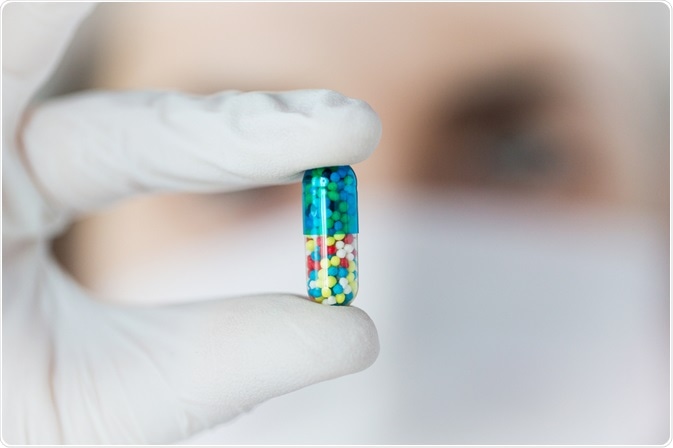Over recent years, molecular docking has become a vitally important method used in the drug discovery process. The pharmaceutical industry is increasingly relying on molecular docking to run structure-based virtual screenings to identify new candidate molecules for development in novel therapeutic approaches.

Drug Discovery. Image Credit: Syda Productions/Shutterstock.com
Speeding up the drug discovery process
The pharmaceutical industry is faced with the challenge of investigating an increasing array of new therapeutic targets for drug discovery. Conventional methods have proven time-consuming and expensive, with research teams dedicating significant amounts of time and money to explore the potential efficacy and safety of candidate molecules that ultimately are rejected during clinical trials. With roughly nine out of ten candidate drug molecules failing to gain approval, the pharmaceutical industry has focussed efforts on streamlining the drug discovery process.
Advances in drug discovery technology have led to several computational strategies emerging with the capacity to speed up the drug discovery process, and limit time wasted investigating molecules that are ultimately deemed unsuitable by using algorithms to predict how molecules will interact with the target.
Virtual screening (VS) is one such computational method that has become popular in the drug discovery process. VS optimizes drug discovery by highlighting molecules that fit the target. To achieve this, two distinct methods of VS are used, ligand-based and structure-based.
Structure-based methods rely on molecular docking to demonstrate how likely a particular ligand is to bind to a target protein. This approach models interactions between candidate molecules and the target protein at the level of the atom. This allows scientists to predict the activity of the candidate molecules at the binding site of the proteins, helping them to select those with desirable behavior and reject those with undesirable behavior.
Molecular docking involves predicting the structural arrangement of the ligand, as well as its orientation and position at the binding site. Molecular docking also involves the assessment of the potential binding affinity between the candidate molecule and the target.
Below we discuss the process of molecular docking in detail.
The process of molecular docking
The molecular docking method seeks to identify the binding mode of a given ligand that best matches with a target, such as a protein. The process involves generating multiple possible conformations and orientations of the ligand with the binding site of the target. Access to the three-dimensional structure of the target is, therefore, vital for this process. This 3D structure can be obtained via numerous methods, such as X-ray crystallography, NMR, or homology modeling.
The process of molecular docking involves two steps. The first is the generation and sampling of conformations/orientations, the second step is the allocation of a score to each predicted pose to determine the likeliness that the molecule will bind to the target with high affinity.
As a result, the process can select molecules that show favorable behavior and a high likelihood for binding to a target with high affinity. There are three main types of scoring functions used in molecular docking: force-field-based scoring functions, empirical scoring functions, and knowledge-based scoring functions.
Classification of molecular docking methods
Docking methods are classified in terms of the degrees of flexibility of the molecules under investigation. There are three classifications: rigid docking, semi-flexible docking, and flexible docking. Rigid docking is where the ligand and target are both classified as rigid and just three translational and rotational degrees of freedom are considered in the sampling phase. This model is most commonly used for protein to protein docking and reflects the “lock and key” model of binding.
In the semi-flexible method, one of the molecules (the ligand) is considered to be flexible, and the target is considered to be rigid. The conformational degrees of freedom of the flexible molecule are sampled, and six translational plus rotational degrees of freedom are also added. Semi-flexible methods assume that a fixed conformation of a target might correspond to the one able to recognize the docking ligands.
The final method of flexible docking assumes that a protein does not behave passively during the binding phase and, therefore, it considers the target protein to be flexible as well as the ligand. There are numerous methods of flexible docking that have developed over the years with some focussing on the model of induced fit binding and others focussing on conformational selection.
Overall, molecular docking is a vital part of emerging technology being developed to improve the drug discovery process. Methods like molecular docking are facilitating the development of novel therapeutic offerings and are helping to speed up the drug development process as well as bring down costs. Already, molecular docking has helped to select molecules that have gone on to be approved for use in new medicines for a variety of diseases and illnesses.
Sources:
- Kitchen, D., Decornez, H., Furr, J. and Bajorath, J., 2004. Docking and scoring in virtual screening for drug discovery: methods and applications. Nature Reviews Drug Discovery, 3(11), pp.935-949. https://www.nature.com/articles/nrd1549
- Meng, X., Zhang, H., Mezei, M. and Cui, M., 2011. Molecular Docking: A Powerful Approach for Structure-Based Drug Discovery. Current Computer Aided-Drug Design, 7(2), pp.146-157. https://www.ncbi.nlm.nih.gov/pmc/articles/PMC3151162/
- Salmaso, V. and Moro, S., 2018. Bridging Molecular Docking to Molecular Dynamics in Exploring Ligand-Protein Recognition Process: An Overview. Frontiers in Pharmacology, 9. https://www.frontiersin.org/articles/10.3389/fphar.2018.00923/full
Further Reading
Last Updated: Mar 18, 2021